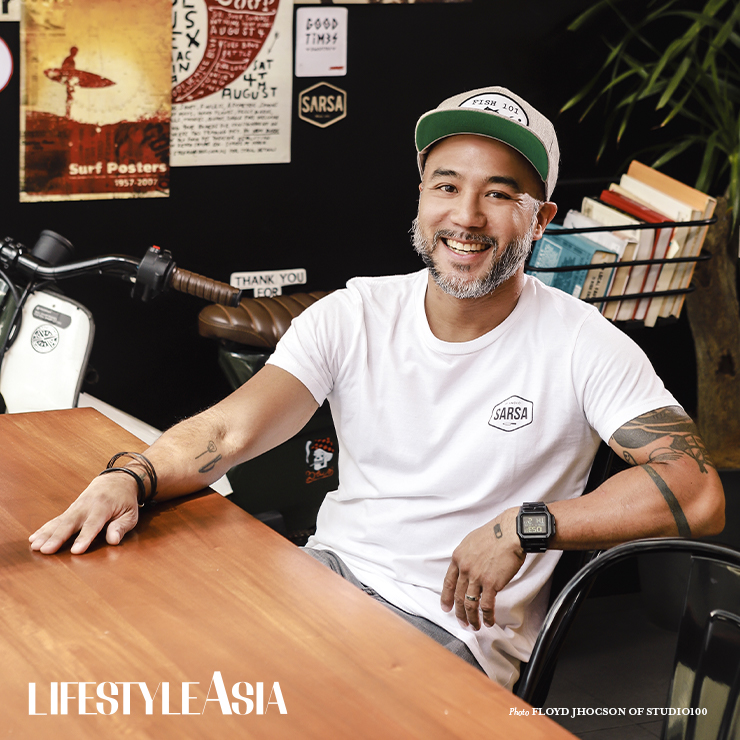Chef JP Anglo shares how he is elevating Filipino cuisine, one dish at a time, and how others can join the movement toward putting our dishes on the global culinary scene.
At last year’s San Sebastian Gastronomika in Spain, the boodle fight—a classic Pinoy dining experience—made its debut at one of the world’s most prestigious culinary events. On stage, Visayan classics like binakol and inasal—presented with a twist—and other Filipino dishes came alive for top chefs and food savants to feast on. Ilonggo chef JP Anglo, along with his team, orchestrated this symphony of Pinoy flavors, presenting a master class in Filipino cuisine, culture, and values.
Naturally, Chef JP’s dream banquet would also be a boodle fight with a few special guests. “I would invite Anthony Bourdain, David Chang, Kobe Bryant, and my grandfather. We’d have a boodle fight on an island, and we’ll use all local ingredients. Using a coconut, the meat can be made into salsa. The water will be used for chicken binakol. The husk can be our smoking agent. The oil, pang-gisa. Then, we’ll use banana leaves for plates. I think that would be fun.”

Igniting The Passion
Before he became the renowned chef that introduced the boodle fight to the global culinary zeitgeist, young JP Anglo was a wide-eyed dreamer with a fascination for kitchens. From his childhood memories, he fondly recalls an image of a chef cooking fried rice in a Chinese restaurant. “You know how you can see the chefs cooking with a wok that they put over large flames? That ignited something inside me,” he recalls. “Every time I would look at the kitchen, it would stimulate me. My mind would start to think, ‘how do I do that?’ So, I would try what I would see back at home. You can say that I’ve liked feeding people at a young age pa lang.”
Chef JP allowed his childhood curiosity to develop into a lifelong passion, but not without difficult character-building experiences. He recalls juggling culinary school and work in Australia, and how this episode—though difficult and stressful—proved to be one of his most formative career moments. “Back then, I thought of quitting every day. I considered being a gardener, a bricklayer, or even a hairdresser,” he quips. “These random jobs crossed my mind then because it was so difficult in the kitchen. Wala kang life. Palagi kang pinapagalitan. You have to go through it eh. My chef mentor would always say, ‘one day, when the right time comes, when you’re ready, you’ll just figure it out.’”
Returning To One’s Roots
Chef JP’s passion for serving great dishes is best seen and experienced at Sarsá Kitchen+Bar, his homage to his Visayan roots. “Sarsá is a full-circle moment for me. I started with a Chinese restaurant, an Asian one next, then Ilonggo food. I am Filipino, I am Ilonggo, I am from Bacolod. Of course, I should be cooking our meals!” he exclaims.
At its core, Sarsá gives diners a slice of Chef JP’s lifestyle and culinary experiences, from the beach and island living-inspired interior decorations to the distinct Ilonggo flavors on the menu.
“The isaw, chicken inasal, batchoy—mostly Ilonggo favorites—are some of our bestsellers. Personally, isaw, pansit molo, monggo, garlic rice, and pork barbeque,” he shares.
“With Sarsa, I wanted to pay homage to my roots and the food I grew up with. I wanted to elevate humble provincial cuisine a little bit more—kasama na diyan ang flavor, plating, kasama na ang vibe, ang music. It’s all about giving people a better experience when it comes to Filipino food.”
Read the full story written by Gelo Diorona in Lifestyle Asia’s November 2020 edition titled, “Rising Together.”





